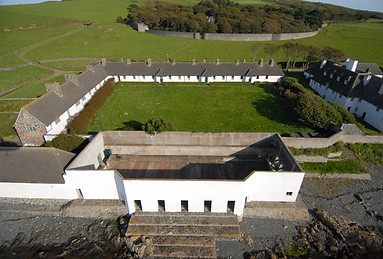
The isle of Lambay is the family seat of the Revelstoke branch of the Baring family and home to Lambay Irish Whiskey. It is owned and protected today by the Revelstoke Trust and daily management lies in the hands of Alex Baring (7th Baron Revelstoke) and his sister Millie Baring, with invaluable support from the wider Lambay family.
Nestled in the Irish Sea just four miles off the coast of County Dublin, the island is a square mile in extent (630 acres), making it the largest island off the east coast of Ireland and the largest privately owned island in North-West Europe.
It is a paradise of fine architecture, birds, flowers, cattle, seals, fallow deer and even a mob of wallabies! The island is internationally important as a Natura 2000 site designated for its breeding seabirds and as home to the largest breeding colony of North Atlantic Grey Seals on the east coast of Ireland. It holds a remarkable place in European natural history as the site of a pioneering biological investigation undertaken by the naturalist Robert Lloyd Praeger in 1906, as a mutual project with Cecil Baring, during which they found several new species including three earthworms, a bristletail and a mite.
Entirely off-grid and unattached to the mainland by so much as a cable or pipe, the island is partially run on green energy generated by solar panels and a wind turbine that are rigged up to a complex battery system that baffles us at the best of times, but does the job! The natural spring gives us fresh drinking water year round, which is also used in our very own island whiskey, aged in old cognac casks where they can breathe in the salty sea air.
An Island History

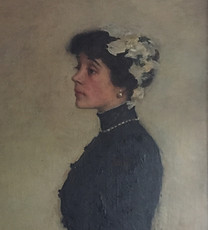
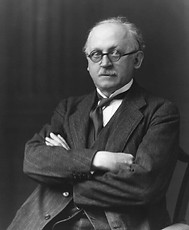
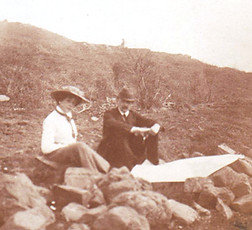
The private isle of Lambay is an extraordinary place. The island came into the hands of a newly-wed couple in 1904, Cecil and Maude Baring. Together with the visionary architect Sir Edwin Lutyens, they embarked on a project that would immortalise their love story and survive for generations after they were gone.
Cecil, Maude and 'Ned' Lutyens turned Lambay into a beautiful home and destination for creative and bold minds: the 15th Century fort became a Romantic Castle with plumbing and open fires in every room; the Coastguard Cottages were renovated for residents, a working farm was built and the stunning C19th Chapel brought back to life.
They chose to leave no expense spared in creating a magical place committed to creativity, quality of craft and attention to detail. They had a vision, and they made it a reality. Lambay became their secret haven; a paradise of birds, wildlife and stunning architecture where they could immerse themselves and their friends in creativity and pursuit of a life less ordinary.
On the wilder parts of the island seals, puffins, cormorants, kittiwakes, shags and gulls mingle with deer, wallabies and free roaming cattle and sheep. In Spring the island is covered in a rich, purple haze of bluebells; in Summer the bright yellow gorse flowers pepper the hillside. The entire island is off-grid, powered by wind and solar energy for all its electricity and supplied by its own fresh spring water source, Trinity Well, which is also used in the production of the island's very own Lambay Whiskey.
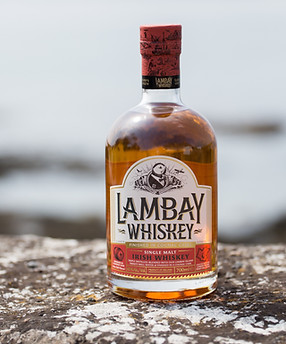
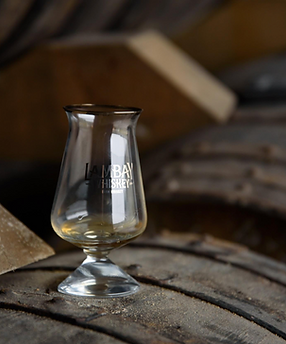
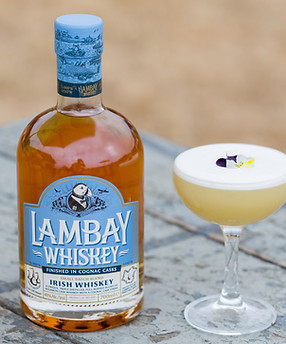
B.B. (BEFORE BARINGS!)
The remnants of a vast volcano, Lambay emerged after two continents joined to create Ireland 450 million years ago. It is formed from a beautiful flecked green stone – porphyry – from which our Neolithic ancestors made handsomely crafted stone axes 7,000 years ago.
Its early history is obscure but, like many other small islands, it attracted saints, hermits and pirates. It is thought to be one of the first few places where Viking raiders landed and proofs of its prehistoric history and early modern settlement were found around the harbour which date from the 1st century AD. Excavations also revealed Iron-Age graves dating back to circa 500 BC, in which were found small sticks of a pink, wax-like substance very similar to modern lipstick. Some of the artefacts, including a bracelet, can be seen today in The Dublin Museum.

In 1181 the island was granted to the Archbishops of Dublin, Christ Church Cathedral.
By 1467 it was described as "a receptacle for the King's enemies, to the annoyance of the mainland," and a licence was granted to build a fort to protect against invasions by the Spanish, French and Scots. Sir John Challoner is thought to have actioned the licence in the early 1500s. The conditions were that Challoner would within six years build a village, castle and harbour for the benefit of fishermen and as a protection against smugglers. He was to inhabit Lambay "with a colony of honest men". He was a very active man who worked four mines for silver and copper and bred falcons on the island's many cliffs.
In 1611 the island moved from the Church into the private hands of the Ussher family for 200 years, during which time it was used as a Prisoner of War camp for over 1,000 Irish soldiers during the Williamite war after the Battle of Aughrim. From 1805 the leasehold passed through several hands, including those of Sir William Wolseley and the Talbot family of Malahide.

The island has claimed a number of shipwrecks, the most notable of which was the RMS Tayleur. One of the largest merchant ships of her day, she struck the island on 21 January 1854 just hours into her maiden voyage from Liverpool to Melbourne, Australia and sank. Of more than 650 aboard, only 280 survived.
One story goes that one of the survivors who made it onto Lambay was an on-board chef of African-American descent. The island inhabitants had never before seen a black person and, assuming he must be some form of other-worldly spirit, they refused to open their doors to him!
The bodies that were recoverable from the sea are today laid to rest on Lambay around the island's Chapel. While their graves are unmarked, they received a proper burial and blessing and the island feels at peace.
In 1903, Cecil Baring (later the 3rd Baron Revelstoke) and his beautiful American bride, Maude Lorillard saw an advert in The Field for an "island for sale" in the Irish sea. It caught their eye for several reasons (which you will read about below) and within the year, on the 1st April 1904, Lambay was theirs for the princely sum of £5,250.
Also of enjoyable note: Lambay was the landing site of the winners of the 1921 Gordon Bennett Gas Balloon Race. The pilots were Captains Armbruster and Ansermier, both Swiss. They took off from Brussels and flew 756 kilometres in 27 hours and 23 minutes before landing on Lambay. We have no doubt they would have received a warm welcome in the Castle and a glass of whiskey to celebrate, and they now feature on our Lambay Whiskey bottle in the little illustrations around the cork foil!
The Revelstokes
LAMBAY & THE BARINGS
Lambay's history under the Baring family took a turn for the deeply romantic and, with the arrival of Cecil (Baron Revelstoke III) and his wife Maude in 1904, the island fell under an enchantment that still mesmerises visitors to this day.
Maude was the younger daughter of the American millionaire tobacco manufacturer, Pierre Lorillard, who owned Tuxedo Park in New York. A lively and active woman, she escaped the constraints of home before her 18th birthday by marrying Tommy Tailer, a wealthy New York socialite, in 1893. Tommy was a partner in the New York branch of Baring Brothers and, through this connection, met one of the family members of the bank - this was Cecil.
Cecil, born in 1864, was a brilliant student educated as a Classicist at Eton and Balliol. Maude playfully nicknamed him "Caesar" for his baldness and long nose, which also suited him as he enjoyed music, philosophy, literature and was a talented composer of occasional verse. At Oxford, he also became fascinated by natural history.
The near collapse of Baring Brothers in 1890 drew Cecil closely into the family business and took him to New York. There, he entered enthusiastically into the cultural life of the city and also created — with Tailer — a Real Tennis court at the Tuxedo Club.
By the end of the 1890s, Maude's marriage to Tommy Tailer fell apart after he was unfaithful to her. Cecil left New York in 1901 and it was then that Maude realised she had loved him all along. A maverick for her time, she secured a divorce from Tailer and in November 1902, was remarried in London to Cecil.
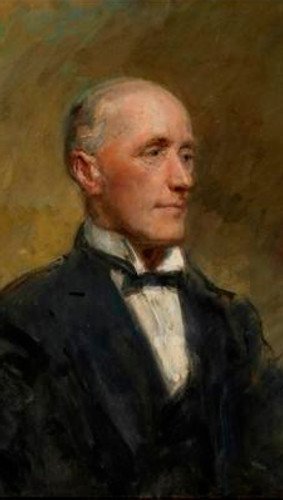
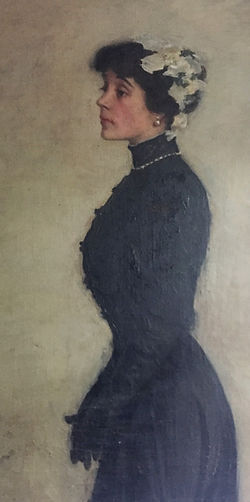
Such was the scandal of Cecil marrying a divorcée (and an American one, at that!) that he was encouraged to step down from his responsibilities at the bank. It was this yearning to escape from the critical public eye, mixed with Cecil's passion for island ecologies, that led the betrothed couple to seek the peace and solitude of Lambay.
In early 1904, with Maude heavily pregnant, Cecil went to investigate Lambay; he found a small line of cottages occupied by coastguards, a chapel, a walled garden, a dilapidated old fort and a magnificent wealth of wildlife. It was an intoxicating mixture.
The first task facing the Barings was the repair of the castle and they refitted a heavy lugger, the Shamrock, to carry the necessary materials to the island. The Shamrock (version 3.0) is still in use today as Lambay's main cargo boat and is used to transport the sheep and cattle as well as bulkier materials and equipment for the off-grid energy system.
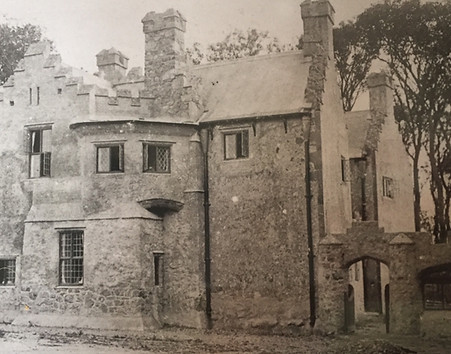
A full year elapsed before the castle was habitable and it was not until June 1905 that it was furnished. Immediately thereafter, Cecil convened a congress to examine the flora and fauna of the island, the findings of which were published in The Irish Naturalist (1907).
He also tried to introduce new species, including mouflon sheep, chamois goats, kinkajous and rheas. Today, there is a large population of wallabies on Lambay, but these were brought here in the 1980s by Cecil's son Rupert Revelstoke, who had enjoyed having two pet wallabies in the 1950s.
Now captivated by the island, the Barings determined to undertake more ambitious changes to the castle. They invited Sir Edwin Lutyens, renowned architect of the Arts & Crafts movement, to visit in August 1905.
Lutyens was utterly delighted by Lambay and the couple, and the visit sparked a warm friendship between the three of them that would last throughout their lives. Lutyens extended the Castle masterfully and by 1910 it was a beautiful refuge for Cecil and Maude, surrounded by an impressive circular wall, which Lutyens nicknamed "The Ramparts Against Uncharity".
Cecil and Maude had 12 blissful years together with their little family on Lambay but alas, in 1922, a still young Maude died of cancer, leaving Cecil with two daughters, Daphne and Calypso, and a young son, Rupert. Her body was brought back from London to the island for burial. Lutyens, who was then busy with war memorials and the government buildings of New Delhi, designed a large monument for her grave, set in against the rampart walls and facing towards the Castle. The mausoleum is today one of the most pleasant and peaceful spots on the island. Prefacing Cecil’s epitaph, a beautiful poem about his wife, is the word ‘Quiet’, both an imperative to the reader and a description of the monument’s setting.
QUIET
She that to us was loveliest and best,
Child-cradled in the earth, lies here at rest.
The little lowly flowers on her grave
Weep for the life they had no skill to save.
She sleeps, that did embody as she stood,
The picture of perfected womanhood.
Sleeps while the birds that hold this place in trust
Pipe low for pity o'er their comrade's dust.
Fearless she lived, and innocently laid
Life down ere youth had yet begun to fade.
Bow and bethink thee, thou that passest by,
How clear a worth could with one woman die.
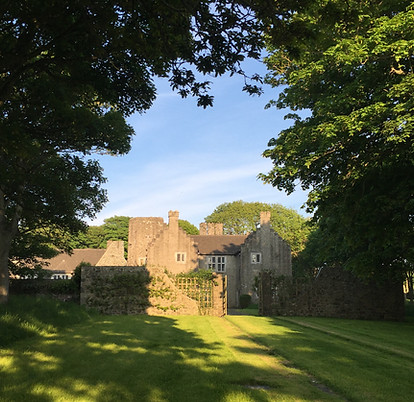
Cecil died in 1934, but not before commissioning a final piece from Lutyens for his two daughters and their many children. The White House (or Baby-lon, as Lutyens dubbed it) was built in 1932-33, completing the shoreline quadrangle made up by the Coastguard Cottages, Real Tennis Court and Bothy. Cecil's son Rupert took up residence in the Castle as the 4th Baron Revelstoke and married Flora Fermor-Hesketh; together they had two sons, John and James Baring. Despite his deep and lasting love for Flora, Rupert proved to be something of a lone wolf and so much devoted to Lambay that, a few years into their marriage and with Flora's approval, he made the tactful suggestion that his good friend Derek, who had been quietly in love with Flora for many years, take on the duties of matrimony. Flora and Derek stayed in close contact with Rupert and the three of them often spent Christmas together at Easton Neston, with the boys and Flora and Derek's two daughters. In the meantime, Rupert fell deeper in love with Lambay and commenced an extraordinary record of photos, letters, doggerel, visitors' books and egg collections which document the enchanting island's history through the second half of the 20th Century.
Rupert's eldest son John did not have any children and spent a great deal of his adult life in Kenya. James, the younger, had two sons and two daughters. These, the fourth generation entrusted to protect Lambay, are your present day hosts. As children Alex, Tom, Aksinia and Millie would spend glorious summers on Lambay with cousins, visiting their eccentric Grandpa Rupert who spent most of his latter days sat comfortably in his study, smoking cigarettes and drinking whiskey. A visit to Grandpa's Study most memorably involved being directed, after a suitably tantalising delay, to the cupboard by the door, wherein could be found stacks and stacks of Cadbury's milk chocolate next to the whisky and coca-cola stash. "We would sit and enjoy our chocolate and coca-cola with due reverence," recalls Millie, "and discuss Important Matters with Grandpa for half an hour, before scampering off to make Irish soda bread in the kitchen with Eileen, his wonderful housekeeper. The smells of my childhood still fill the Castle today."
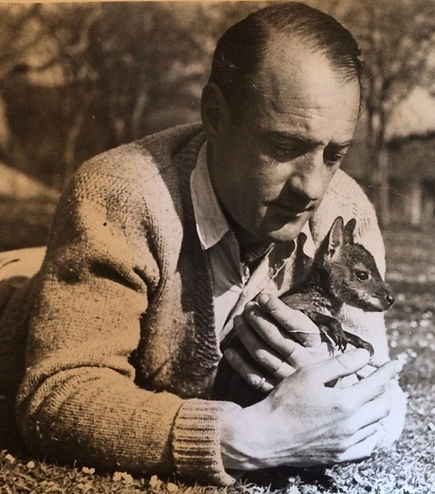
Rupert Revelstoke bottle fed his baby wallabies in the Castle gardens, 1950s
Daphne and her family continued to visit Lambay regularly and made the White House their summer home. Calypso had many children, too, but eventually was drawn back to her mother's roots in America and asked Daphne to take on responsibility for the whole of the Whitehouse.
Rupert passed away in 1994. Neither John nor James had shown themselves as reliable stewards to take on the island estate and so, before his death, Rupert secured Lambay's future by putting it under the protection of The Revelstoke Trust, to which he left all of his assets.
The island was given into the care of Margaret Pollen, the youngest daughter of Rupert's sister Daphne, and her husband Patrick, as they were based in Dublin and willing to spend a substantial amount of the year on Lambay; they were the island's keepers for 18 years.
In 2009 Millie and Aksinia secured a visit to Lambay, having not set foot on it since the Summer of 1994, the last time they saw Grandpa Rupert. Full of vivid memories - the smells, the colours, the sounds - it was a magical experience returning to their childhood and finding it utterly unchanged; even Grandpa's study remained just as it had been, with his chair and typewriter just so.
In 2011, following the great market crash in 2008, it was announced to the beneficiaries of The Revelstoke Trust that the island would need to be sold. Fortunately, this sad fate was averted by an agreement among the wider family and trustees to create and implement a business plan with Alex Baring at the helm, which - if successful - would secure Lambay's future within the family.
The day after one of the final meetings in February 2012, which officially instated Alex as the leader of this mammoth project, his father James checked himself into hospital and died peacefully at the age of 73. The doctor, who wanted to perform a risky but necessary heart operation, informed Alex and his siblings that James had rejected the surgery, proclaiming that he had lived a long and fulfilling life and had recently reached a point of success on an important family project. We know, of course, that he was referring to the securing of Lambay for his children and all the descendants of Cecil and Maude, whose initials still emboss the original cast-iron guttering that frames the Castle. Maude's beautiful mausoleum today also holds the body of her husband Cecil, their son Rupert, and the ashes of their grandsons John and James.
You can read a wonderfully personal account of Cecil and Maude's family life in the published memoirs of their elder daughter Daphne Pollen, titled "I Remember, I Remember" (copies of this are obtainable through the family).
Lutyens & Lambay

Lutyens remained a regular visitor after the completion of the Castle and over the next 20 years, his work spanned a truly unique landscape in which he overlooked no detail. Under his direction, the shoreline was transformed with alterations to the existing 19th Century boathouse and the addition of a Real Tennis court with unique arches overlooking the beach. The court, built in 1922, is one of just two remaining outdoor Real Tennis courts in the world and in the 1993 and 1994 (the year of Rupert's death) the London Queens Club champions came to play on Lambay; a montage of photos with a note from Rupert Baring can be seen hanging on the wall in the London-based tennis club.
The adjacent coastguard cottages were also restored and, in 1916, the Catholic chapel (1830s) in the field beyond was rebuilt with a rugged Doric portico in homage to Cecil's love of the Classics. Lutyens also conceived the shallow terracing of the slope above the harbour to create a tantalising dogleg in the approach to the castle from the quay. His final addition, completed in 1933 just shortly before Cecil's death, is the White House. Dubbed "Baby-lon" by Ned Lutyens, this beautiful guesthouse was designed for Rupert's sisters Daphne and Calypso, both of whom had large families. The house has two symmetrical wings, with a shared central living space and main kitchen. This too, was crowned with the signature grey pan-tile roofing used on the other buildings.
The result is a remarkable range of architectural styles that have been seamlessly united by their whitewash treatment and the use of distinctive grey-coloured Dutch pantiles for the roofing. Lambay is regarded by some as Lutyens' finest example of domestic architecture and it remains an extraordinary tribute to his talent and genius. It is also the only remaining example of his work that still holds all the original furniture, much of which Lutyens designed especially for the rooms, making it a truly remarkable sight.
